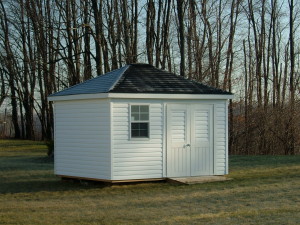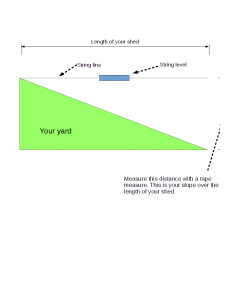
Your yard might have a slope to it, so use this guide to see how much leveling material you will need.
If you’re intending to build a shed with a lot that has a severe incline, or has substantial moisture and water problems, there are a number of issues that have to be dealt with, and you might be limited as to your shed foundation options. Thankfully, no lot is unbuildable, no matter how steep or wet it is, but additional planning and work must be spent to make sure your new shed is stable and secure.
If your lot has a slope to it, many times it’s not severe enough to warrant posting to support it, and some simple measurements will be all that’s needed to determine the severity of the slope. Normally, if your lot’s slope is less than 2′ over the length of the shed’, a concrete block foundation is just fine, unless your yard is very wet for much of the year (such as cases where a natural spring keeps the soil wet), or if your soil is very loose and granular, then posting may be needed on a lesser slope.
To determine your lot’s slope, you’ll need a helper to assist you, and some simple tools such as a string line, a line level, a tape measure, and some stakes. Please see the attached diagram to help you understand the process. Firstly, measure and stake out the approximate area where you intend your shed to be built. This will give you a rough idea of where the boundaries of your shed will be, and will be accurate enough to determine the slope of the ground. After the perimeter of the shed is established, stake down one end of your string line at the corner of the shed where the ground is the highest. Run out enough string to extend past the opposite corner of the same side of the of the shed, and attach the string level to the approximate center of the line. Pull the line taut, and have your helper watch the level and adjust the line until the level indicates an approximately level line (it doesn’t have to be perfect, this is just an appropriation, so don’t sweat it too much at all). Once the line is approximately level, use the tape measure to measure the distance from the string to the ground. This will give you your approximate slope measurement.
Slope measurement diagram If the slope is measured at 2′ or less, you are probably OK to consider using a concrete block foundation. This will save you a lot of hassle, time, and expense in the construction of your shed. You should consider using additional levelling points underneath of the shed, and adding additional block sizes to your purchase to include 4×16” solid block, and also 8×16” hollow core block, in addition to the 2×16” block you would normally purchase.
If your lot is sloped greater than 2′, you should consider other foundation options, primarily a posting option, which would consist of 4×4 or 4×6 posts concreted into the ground, and attached to the skids of the shed in the same locations as the levelling points would normally be, or possibly a post-and-beam foundation which would be similar to a posting foundation, but the skids are replaced with 2×8 or 2×10 pressure treated boards and are lagged and bolted into 4×6 posts. Look for our blog post covering posting foundations and post-and-beam foundations to cover these foundation types in more detail.
Please follow us on Twitter at @SBUSHEDS and on Pinterest at @SBUSHEDS for photos of different foundation types and additional shed related content.


Recent Comments